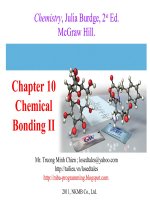Tài liệu Chapter 10: Host-guest chemistry in aqueous organometallic catalysis pdf
Bạn đang xem bản rút gọn của tài liệu. Xem và tải ngay bản đầy đủ của tài liệu tại đây (303.27 KB, 11 trang )
Chapter 10
Host-guest chemistry in aqueous organometallic
catalysis
10.1 Cyclodextrins and the formation of inclusion
compounds
Host-guest complexation relies on interactions of molecules through
secondary chemical bonds. Such complexation can lead to formation of
loose associations, as well as to that of very stable adducts. In formation of
these addition compounds, important roles are played by hydrogen-bonding
and hydrophobic interactions. In certain cases one of the reacting partners
will wind up in a relatively enclosed space, embraced by the other reactant -
this is when the host-guest description is most appropriate. In general, any
such interaction between host and guest is expected to change the properties
of both molecules but it is the host molecule which is looked at with
anticipation of its reactivity being changed in a favourable manner.
Among the best known and most versatile hosts are the various
cyclodextrins [1,2] of which and are the most
available. These are cyclic oligosaccharides built up of six, seven, or eight
glucopyranose units, respectively. These compounds can be prepared by
enzymatic hydrolysis of starch. The undoubtedly most important member of
the cyclodextrin family is which has become a cheap
and easily available chemical, suitable for large scale applications. Schemes
10.1 and 10.2 show the common representations of the cyclodextrin
structure(s), emphasizing the topological difference between the polar outer
surface and the hydrophobic inner face of the molecules. It is worth
mentioning, that while has a rather rigid structure due to
internal hydrogen bonding, and are structurally more
flexible.
279
28
0
Chapter 10
The most important property of cyclodextrins is in their ability to
accommodate guest molecules within their cavity, which has a volume of
per molecule or 157 mL per mol of (cavity diameter 6.0-6.5
Å). In aqueous solution, this cavity is filled with molecules of water the
displacement of which by a less polar guest leads to an overall decrease in
free energy. Stability constants and thermodynamic parameters for
complexation of a vast number of guest molecules can be found in ref. [3].
Chemical modification of cyclodextrins is achieved through reactions of
their hydroxyl groups. Of the 21 hydroxyls of the seven primary ones
(C-6) can easily be reacted. In addition, the C-2 secondary hydroxyl groups
are also fairly reactive while the ones at C-3 resist modification (e.g. by
methylation). Several CD derivatives are available commercially in large
quantities including –among others– randomly methylated and
[2]. Chemical modifications substantially alter
the solubility of cyclodextrins in water. For example, the solubility of
Host-guest chemistry in aqueous organometallic catalysis
281
is at room temperature, while that of
is much higher (allowing preparation of even
a 50 % solution). Very interestingly, on heating a clear 10 %
aqueous
solution of a sudden crystallization occurs at about 55 °C
within a range of 0.5 °C [1]. This phenomenon may be worth of keeping in
mind when applying methylated in reactions at high
temperatures.
The chemical reactivity of a guest molecule may be influenced by
complexation to a very large extent. One major application of cyclodextrins
is based on their ability to protect their guests against oxidation which is of
paramount importance for formulation of oxidation-sensitive drugs or
flavour substances. On the other hand, reactions of certain compounds can
be largely accelerated by inclusion into the cyclodextrin cavity - generally
this results from proper positioning of the substrate (guest) towards a
catalytic entity, which may be one of the CD hydroxyls or even a metal ion
attached to a functionalized cyclodextrin molecule. This is this latter
property which is the most attractive from the aspects of aqueous
organometallic chemistry. Finally, being water soluble, cyclodextrins can
serve as (reverse) phase transfer agents transporting organosoluble
substrates into the aqueous phase for further reactions.
It would be unfair to leave unmentioned other host molecules, capable of
promoting catalytic reactions in aqueous media. Appropriately modified
calixarenes and crown ethers have been used sporadically for such purposes.
Although the potential of very specific applications of these host molecules
cannot be denied, from the practical view of availability and price, however,
these are a far cry behind cyclodextrins.
10.2 Application of cyclodextrins and other host molecules
in aqueous organometallic catalysis
An overview of the literature on the application of host-guest interactions
in aqueous organometallic catalysis reveals the following:
in most cases (almost exclusively) cyclodextrins were used as hosts,
majority of the reactions in such systems were catalyzed by complexes
bearing a sulfonated phosphine ligand, and
majority of the above reactions involved higher olefins or aromatics.
In principle, cyclodextrins can interact with both the substrate, the
product and the catalyst of a catlytic reaction mixture. Indeed, this is what
happens.
The interaction of TPPTS with has been investigated in detail by
uv-vis, circular dichorism, and NMR and electrospray mass
spectroscopy [4,5]. The main conclusion of these studies is that one of the
282
Chapter 10
sulfonated phenyl rings of TPPTS is included into the cavity of and
that the complex formation constant at 298 K is approximately
Most probably 2:1 and 3:1 CD:TPPTS complexes are also formed in a small
extent but their stability constants could not be quantitatively established.
Nevertheless, this means that in a catalytic application there is a competition
for between the substrate and catalyst molecules although substrates
can win this competition owing to the their (usually) large excess over the
catalyst. In addition, the product can also take part in this competition and if
an organic solvent is used it should obviously be chosen carefully in order to
avoid its strong interaction with the cyclodextrin.
Attachment of a catalytic unit to the cyclodextrin torus can be achieved
by seve
ral modifications. One recent example is shown on Scheme
10.3
(although no catalytic application of complexes with this ligand have been
disclosed yet), other modified cyclodextrins
(
126-128
)
are depicted in
Chapter 2.
Hydrogenation of unsaturated carboxylic acids, such as acrylic,
methacrylic, maleic, fumaric, cinnamic etc. acids was studied in aqueous
solutions with a catalyst in the presence of and
permethylated [7]. In general, cyclodextrins caused an
acceleration of these reactions. It is hard to make firm conclusions with
regard the nature of this effect, since the catalyst itself is rather undefined
(probably a phosphine-stabilized colloidal rhodium suspension, see 3.1.2)
moreover the interaction of the substrates with the cyclodextrins was not
studied separately.
was modified by attaching 2-(diphenylphosphinoethyl)-
thio-
(
127
)
and 2-bis(diphenylphosphinoethyl)amino-
(
126
)
moieties at the
C-6 position [8-11]. The resulting macroligands were reacted with
to provide the corresponding cationic rhodium-
bisphosphine complexes. These catalysts showed pronounced selectivity due
to complexation of the substrate by the CD unit adjacent to the catalytically
active metal center. For example, in competitive hydrogenation of similarly
substituted terminal olefins (Scheme 10.4), 4-phenyl-but-1-ene was
Host-guest chemistry in aqueous organometallic catalysis
2
83
preferentially hydrogenated over 1-decene, up to the ratio of 87/13 [11].
Since these rhodium complexes are highly water soluble, these reactions
could be carried out in aqueous/organic biphasic systems, too. Note, that no
selectivity was obtained with the analogous complexes lacking the
cyclodextrin substituent in their ligands.
Complexes of Rh, Pt, and Pd with the same ligands were active in the
biphasic hydrogenation of chloro- and bromonitrobenzenes. At 80-100 °C
and 20 bar pressure the main products were the corresponding chloro-
and bromoanilines, up to 99.8 % yield (Scheme 10.5) [12]. The selectivity of
similar reactions catalyzed by a Rh/TPPTS was only about 90 %, i.e. the
attached cyclodextrin moiety further decreased the extent of
hydrodehalogenation, probably by complexation of the halonitroaromatic
substrate.
The rhodium complex prepared from and (1R
,
2R)-
N,N’-dimethyldiphenylethylenediamine was found to be a catalyst for the









